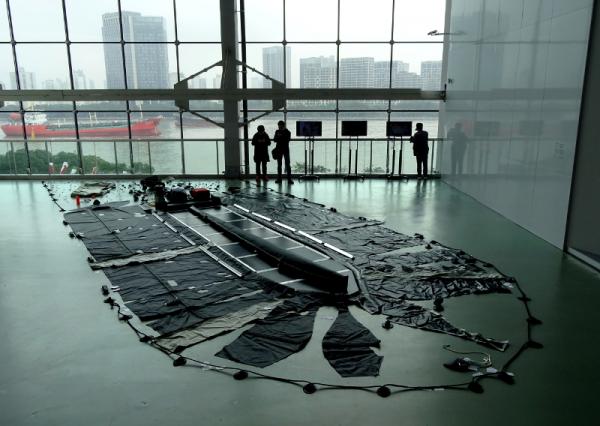
Plastic raft of Lampedusa
Plastic raft of Lampedusa, Shanghai to Berlin
Due to Matsuko being critically unwell in 2017 - this is a placeholder for Plastic Raft and does not contain information about all the people who worked on the project - please contact us a for a full account.
Somewhere in Europe, an artist is downloading Theodore Gericaults 1818-19 painting of the Raft of the Medusa and is busying themselves for a field-trip. An EasyJet ticket to Italy and on to Lampdusa. Armed with an artistic license they visit the morgues to take colour samples of dead and decaying skin. They study the bloating effect of drowning, and are fascinated at how rigor mortis of people clutching onto the handrails of sinking ships keeps the bodies sculpturally connected under water. The artist plans to ask survivors of the recent attempts to get to Europe to help re-enact their journeys so their photos can be collaged into the Raft of the Medusa. Driven on by the rhythmic knocking of dead skulls underwater he thinks of coconuts being banged together as he excitedly replaces the figures on the metaphorical raft with migrant Africans, Arabs and people from the Indian subcontinent. The art will eventually adorn the art institutes of Europe allowing for the intelligent and tasteful to consider something of the sublime suggested by Edmund Burke. Maritime disaster, allows us to read empathic sensations that make the European feel civilised while the crabs continue to eat the drown bodies of migrants.
Another artist, is busying themselves taking plaster cast moulds of a wide spectrum of migrants holding suitcase, bundles of cloths and walking. The casts will be forged in bronze as the inverse of Anthony Gormley's Liverpool beach sculptures Another Place 2008. This artists sculpture will occupy Opposite Tllbury Dock the arrival place where the ship, Windrush landed in 1948. It is full of Caribbean migrants to fill the place in production left empty by all the war dead of the previous decade. The artist imagines figures will emerge from the ooze of the Thames mud on to the shores with people looking hopefully toward the land.
Some where else a group of geographer-artists have organised a boat to be shipped from the Lampedusa ship graveyards to be placed on top the the forth plinth in Trafalgar Square, London.
The works sketched out above could trap us by their affectedness into feeling our own responses, our measured civilisation made safe through artifice and aesthetic rendering. Pushing us toward outmoded humanist notions that would remake the space's, mechanism of governance and the place of technical objects within this domain.
plastic raft from Harwood YoHa on Vimeo.
The European migrant crisis is often rendered within this spectacular humanist form. The raft of Lampedusa is not concerned with the morals of the migrant crisis. Nor is an attempt to re-invoke the sublime of European aesthetics indicated by Edmund Burke, in Philosophical Enquiry into Our Ideas of the Sublime and Beautiful (1757) where he juxtaposes his key concept of terror with the vastness of the sea.
“No passion so effectually robs the mind of all its powers of acting and reasoning as fear. For fear being an apprehension of pain and death... the ocean is an object of no small terror. Indeed terror is in all cases whatsoever, either openly or latently the ruling principle of the sublime.”
This project is about a plastic boat whose journey from China to the Mediterranean sea takes place in the seas lack of fixity, the space between different state actors and administrative disciplines.

The flows of seas distances it from the norms of land, it's state actors and fixed capital investments. We can think of this space in which our little plastic boat travels as a kind of placelessness, a hetrotopia that works to both, shore up or reinvigorate established forms of power and at the same time sow seeds for utopian vision at the ecological/economic margins. (for pirates etc to demonstrate the safety and order of state actors and experiment with new forms of living) This placelessness of sea, allows for different scales of the imaginary to gives birth to new social, political and physical bodies that are squeezed out from the contradictory pressures between freedom of movement for trade and control of more fixed assets, borders, shipping and undersea resources.
In Europe we can see this complex formation express itself in the migrant crisis. The rancid flesh of the dead, the knocking of drowned skulls of the Mediterranean help to make the wealth, freedom and civilisation of Europeans visible. Europe’s necropolitics of the Mediterranean need exploration, there is a whole validation process that goes on, aesthetic, cultural, social, political and economic which could be explored by unpicking a plastic raft.
Being at sea in our inflatable boat, implies a certain proximity to death. An environment were technical objects such water craft become inseparable from the life of humans. An under explored space where technical objects and human bodies historically and contemporaneously conjoin. It is a transversal space where technical objects and flesh, fuse and reform into new bodies. Being at sea questions many assumed forms of European phenomenological, political thought and philosophical renderings.
We can think of this scenario as an extreme version of what we have been seeing with our relationship to digital technologies, where different bodies emerge. Ones that are a transversal collaboration with technical objects and the administrative machinery of advanced capitalism.
“stories of rubber boast being imported from China and transhipped in Malta and Turkey are supported by a recent interception by Maltese customs of 20 packaged rubber boats in a container destined for Misratah, Libya.” EUNAVFOR MED Secret report - Operation SOPHIA, Six Monthly Report: June, 22nd to December, 31st 2015, WikiLeaks release: February, 17th 2016

As this snippet shows, Inflatable boats, four stroke engines are imported to Europe from China, bought from alibaba.com online are transshipped by container to a European destination. The boats are made of Polyvinyl chloride and phthalates that comply to CE and ISO standards an abstract governance that allows the boats to move between economic boarders. The boats use four stroke outboard engines and migrants use balloons for personal effects to make a sea passage possible. The placelessness of seas is contradicted by CE, ISO regulated/disciplined to provide safe passage or protect against liability under normal use.
The Plastic Raft of Lampedusa is premised then on the questions:
What happens if we unpick an inflatable boat?
What holds a body on the surface at sea or allows it to drown?
What forms of governance are at work?
What technical objects and technologies of power reconstruct this transversal being and what new bodies are born from its imaginary?
20170202_transmediale_timelapse from Harwood YoHa on Vimeo.
The sea has consistently transported species, people, wealth, trade, disease, colonisation, oppression and many other scales of exchange between different terrestrial shores. This is consistent at least within human history but some evidence exists that Neanderthals had skin boats and studies in biological evolution reveal oceans as a conveyor belt for other organisms. There is such a profound amnesia around how oceans are implicated in world systems permeating in the 21st century. That is is worth asking why people should forget that two thirds of the earth's surface are covered by water and to whose benefit such a lapse in thought might be profitable?
Watercraft travel across a form of contested commons, terrestrial states attempt to control this outside. Some states create islands, sending in the military to block the claims of others. Others attempt to populate the uninhabitable to protect the potential profit of territorial waters, others usher in contests by planting flags under the ice on continental shelves. The forgetting of the seas allows the powerful to carve up, compete and deplete resources while constructing ideological force fields in a placelessness that is our common inheritance.
Some states see oceans as 'force fields', others see the oceans as transport routes and for many they act as a resource provider.
There is much evidence that people populated the globe by following watercourses and maybe this prehistory of ourselves as herds of wandering mammals without nation is obscured in our present.
Maybe it's the catalogue of horrors such as slavery, war and disease associated with the sea, or maybe it's the blindness of our phenomenology, of being biologically terrestrial, that make the oceans invisible.
Between the 14th and 18th century, Europeans produced artillery and printing, but it was oceanic navigation of Caraval ships, defensive/offensive cannon that had the most global consequence.
Caraval shipping created a remote power that helped propagate the perceived internal unity of emerging states. Any historical reading would do well to include the slippery surface that connects and has formulated much of of language rather then the prevailing view of the landsman of the sea as a barrier.

 bnr#62 => Coal Fired Computers, Tantalum Memorial, Arnolfini, Bristol UK
bnr#62 => Coal Fired Computers, Tantalum Memorial, Arnolfini, Bristol UK